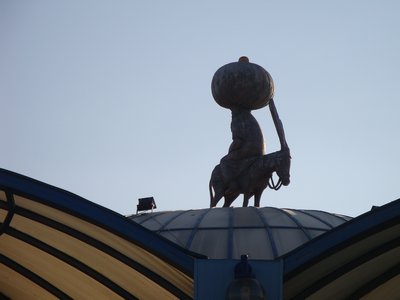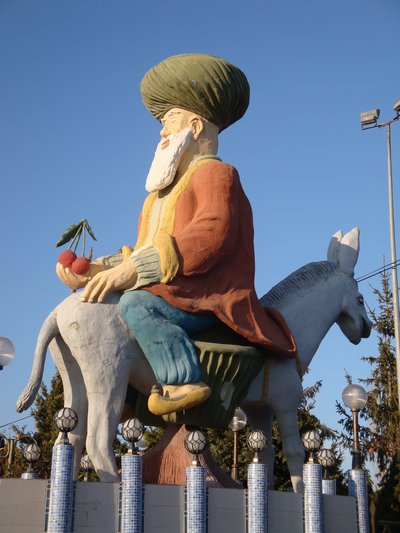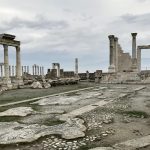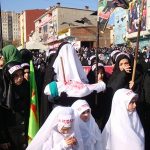A watery sunbeam scythes a line across the flanks of a mountain. The setting sun casts a golden glow on the backs of the sheep. In the grid of plough lines in the fields neat little lines of molehills give victory to the noughts.
All right, let’s be honest. The main reason that I choose to travel back and forth from Cappadocia to İstanbul by bus is that I hate flying. But despite the time it takes there are definite benefits to traveling by land, not least that it enables you to see the changes taking place all over the country.
And what changes might they be?
Well, on a recent trip I saw what has happened to two more of the old caravanserais that traverse the countryside. Restored would be too kind a word for what has been done. Instead the Alay and Tepesi Dilek Hans have been completely rebuilt, in the latter case to serve as a restaurant, named, predictably enough, the Kervansaray. It’s a pattern that has been happening all over the country. Like castles, caravanserais are seen as ripe for rebuilding regardless of whether or not they have a sustainable future in their new form. All too often recently I’ve visited caravanserais that were once romantic ruins to find them rendered utterly soulless by renovation. Weeds are already pushing up through the paving stones surrounding the caravanserai at Tercan. At the El Aman Kervansaray near Bitlis I spent barely five minutes in a vast, bleak space where once I would have lingered for hours to feel the past speaking to me.
But while that may be not good news, on my recent trans-Turkey road trip I also saw three completely new bus stations. Afyon’s new otogar incorporates two small sweets factories so that travellers can idle away their wait while watching men and women clad in white uniforms and masks making pişmaniye and köme. I bet sales have shot up. The bus station as tourist attraction. It’s a new idea but one that surely makes perfect sense.
At Kütahya the bus station has a Space Ageish design that looks as if it’s trying to compete with Afyon’s. Only snag – already the covered path has had to be roped off because a piece of ceiling has fallen down. Corner-cutting on costs, one assumes, which doesn’t look like a charge that could be thrown at Sakarya whose enormous bus station, tiled in jade green, has places for more than seventy buses to arrive simultaneously.
Ah, Sakarya. Just to look at that bus station was to bring tears to my eyes as my mind tripped back to 1999 and the old bus station still standing proud amid the wreckage of an earthquake-shattered city, some of the houses that surrounded it broken down on one side so that they resembled camels kneeling to be mounted.
Of course as a regular bus passenger I have one grouse about these new bus stations which is that they are always out in the sticks, leaving users at the mercy of servis buses to get in and out of town, and making it much harder to plan onward journeys. But that’s to nit-pick absurdly. In the UK one new bus station would be cause for celebration tinged with surprise. Here they are coming so thick and fast that they barely merit a mention.
Restorations, new-builds, I see plenty of those, but there are also the little details one picks up. The fine covered bridge just funded by Selçuk Universitesi in Konya. The Japan-Kyoto Park in the same city. The soaring glass shard that is the Rixos Hotel, still in Konya. The statue of Nasreddin Hoca sitting backwards on his donkey that bestrides the bus station in Akşehir, the town in which he’s buried. And the rather more accessible statue of the Hoca, still to his donkey, at the Kırazlıbahçe service station where we stop for lunch.
As we whisk through İnönü I spot an electricity box with elaborate paintings including one that appears to be of the Galata Tower. As we sit at the traffic lights an eagle rises slowly from a tree beside us, tucking up its yellow legs like the undercarriage of a plane. “Eagle Road,” a friend who regularly drives to Kütahya says she calls it, so my eagle certainly wasn’t a one-off.
Occasionally there’s a mystery to test one’s ingenuity. Some thirty kilometres west of Afyon we pass a strange area where all the ground seems to have been dug out leaving the telegraph poles marooned on plugs of soil. It looks like an archaeological site. More prosaically, I suspect it’s the foundations for a new housing development.
What else did I notice? The long lines of tractors laden with sugar-beet waiting outside the sugar processing plants. The proliferation of thermal hotels around Ilgın, west of Afyon. The lines of trees tracing the water courses. The curious place-names: Gençosman (Young Osman, the name of one of the sultans), Doğrugöz (True Eye), Kapaklı (Lidded), Çay (Tea, or possibly River) and Cumhuriyet (Republic).
Between Nevşehir and Konya it was sometimes possible to see a few mud-faced houses still just about hanging on. Elsewhere, though, the architecture rarely rose above the banal. And everywhere, heartbreakingly, the litter was accummulating.
I broke the journey in Kütahya, putting up in the delightful Ispartılılar Konağı, one of the growing number of hotels housed in old Ottoman mansions, this time in the Gemiyan quarter of town, just doors from the new City Museum and across the road from a restaurant also housed a la the Ottomans. It was a bitingly cold night with ice on the ground and big billows of smoke floating romantically from the vents in the wooden houses. I suppered at the Mülayimoğulları Kebap Salonu on an excellent İskender Kebab in spotless surroundings and with flawless service.
Now, tell me, if I’d flown would it have been a fraction as much fun or a fraction as illuminating? Written: 1 December 2011
Written: 1 December 2011



